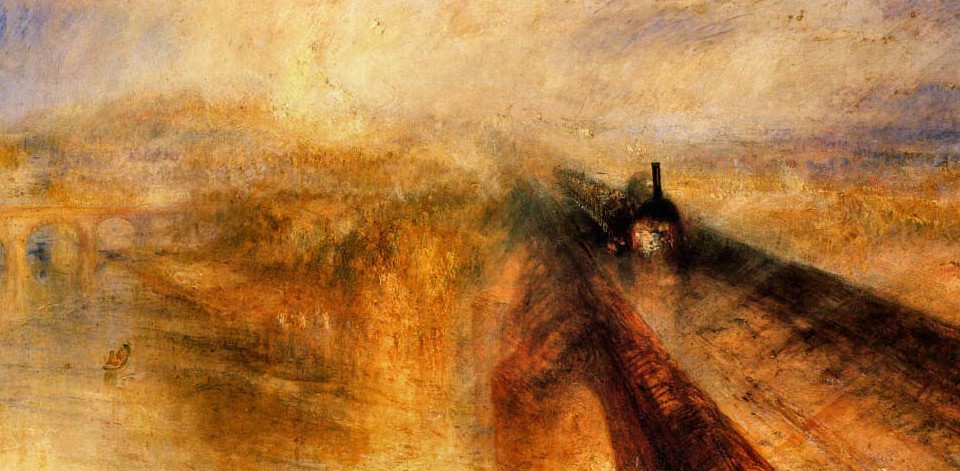Transferred from SubStack 15/4/2024
I just love this painting by the British Romantic painter JMW Turner. I have had a print hanging on my wall for the past 10 years. Is it possible to determine when and in what circumstances it was painted
Turner’s painting could be described as the first Impressionist painting. It is certainly impressionistic, just as Turner described it when it was first unveiled at the Royal Academy in 1844.
Much has been written about the imagery of the painting by others more qualified than I so I shall focus on different matters
Location, location,location
Isambard Kingdom Brunel finished the bridge in 1838. It must have been painted after this year. Turner had lived at Sandycombe Lodge, a house he had designed and built after having bought a plot of land in 1807. He lived there between 1813 and 1826, moving back to his house in Marylebone due to his Father's ailing health. He certainly knew the area well from his frequent walks along the towpath and from fishing the river.
The painting shows a broad gauge locomotive crossing the Thames via the Maidenhead Railway Bridge on the Great Western Railway. At this point the bridge runs East - West. With the road bridge on the left of the painting this puts the point of view somewhere on the western side of the bridge close to Buck’s eyot, a small island renowned amongst eel fishermen and now known as Guards Club park. This may well be where the group of people are standing. The image is created at the same elevation as the bridge although there seems to be no geographical feature that would allow this.
Let's dig a little deeper.
The Maidenhead Bridge was designed by the Great Western Railway Company's engineer, the famous mechanical and civil engineer Isambard Kingdom Brunel. It was completed in 1838, but not brought into use until 1 July 1839.

"As originally built, the Maidenhead Bridge possessed a length of 235 metres and a width of 9.1 metres. It was visually symmetrical about the central river pier, which was founded on top of an existing small island sited roughly midstream in the river. The two main arches had a semi-elliptical shape, each having a span of 39 metres with a very low rise of 7.4 metres. The approach viaducts featured four round-headed flood arches; the short arches nearest the river bank having a span of 6.4 metres while the six flanking arches having an 8.5 metre span each. The elevations were identical and had Doric pilasters positioned between the river and bankside arches and corniced parapets throughout, while the deck comprised a series of stone slabs. The brickwork, both on the elevations and under the arches, was executed in London stock brick.
The innovative low-rise arches over the Thames became subject to considerable controversy concerning their stability or purported lack thereof. During the construction of the bridge, the timber centring used to build the arches was eased; on the eastern arch, the three lowest rings of brickwork began to settle, separating from the body of the arch across a section of between 7.6 metres and 9.1 metres. Critics were keen to hold this up as proof that the design of the arches was flawed. However, it was soon established that the problem had been a product of the mortar having not been fully hardened, while also appeared worse on the spandrels than midway underneath the arches. During July 1838, William Chadwick, the contractor, acknowledged his responsibility for this occurrence.
Remedial work was carried out before the centring was eased again in October 1838. The centring was then left in place over the winter. Author E.T. MacDermot has claimed that, as the bridge neared completion, the board of the Great Western Railway themselves had doubts that the arches would be able to stay up under the weight of passing trains and issued an order to Brunel, instructing him to leave the wooden formwork used to construct the arches in place. However, Brunel decided to lower this formwork slightly so that it provided no structural effect, but gave the appearance of being in place and supporting the bridge. Later on, the formwork was washed away during heavy flooding, but the bridge remained standing with no ill effects; in light of this happenstance, the strength of the arches was finally accepted and Brunel's design was vindicated.”
source: Wikipedia
Would this Scaffolding be the means by which Turner was able to access his viewpoint?
Rain
Although accurate temperature records have only been kept since 1880, there is database of British records. The Central England Temperature (CET) series is the longest-running instrumental temperature series in the world. By collating and combining early instrumental records, the series charts monthly temperature statistics from 1659. The series is representative of a region enclosed by Lancashire, London and Bristol. Right in our target time-frame and location
The years of 1836-1840 were largely snowy, cold and wet.
The severe winter of 1837/8 was called "Murphy's Winter"; Patrick Murphy won fame and a small fortune from the sale of an almanac in which he predicted the severe frost of January 1838. Winds blowing in from the South East brought very cold weather. The Mercury fell to -26C at Beckenham in Kent and other places recorded temperatures below -10C. The Thames at Greenwich was completely covered with ice at high water on the 27th January 1838. Elsewhere, ice floes were reported in the Thames and further down in the Estuary.
1838 saw many violent gales. Cold and frosty weather persisted throughout the late summer, destroying crops right until Harvest time. Crops whose germination had already been delayed by the harsh weather of the previous year.
1839 was also a year of big winds and harsh gales sweeping in from the South West. By 1840 the weather was improving and 1841 was one of the dryest years on record. It seems likely that Turner had completed his masterpiece by that time.
The scaffolding mentioned above had been left in place from October 1838 and was washed away in later storms. The bridge was not opened until 1 July 1839. This month was very wet. In fact the rainfall for the period from June to October was twice as great as the normal average for southern England, however the bridge had been used on 31May 1838 to transport the inaugural Directors of the Great Western Railway. Showers of sleet and snow fell on the 14/15th May.
Steam
What kind of locomotives were first used on this railway and is it likely that the painting shows one of them?
19 locomotives were ordered by Brunel for the GWR from 6 manufacturers and delivered within the years we are looking at. (This Article is very informative.) Narrowing that down to one is tricky. I think the most likely is the North Star, simply because there appears to be a steam dome behind the smokestack.
This locomotive on The Great Western Railway (GWR) was one of a pair of Star Class of 2-2-2 broad gauge steam locomotives that were used for passenger train work.

These were called the North Star and the Morning Star.
They were built in 1836 by Robert Stephenson & Co. Originally destined for the New Orleans Railway, which had a gauge of 5 ft 6 in. That railway experienced financial difficulties, and was unable to accept them; Stephensons sold the locomotives to the GWR, altering the gauge to 7 ft 1⁄4 inch before delivery, and in the case of North Star, also fitting 7 ft 0 inch driving wheels in place of the original 6 ft 6 inch wheels.
Another contender might be the Aoelus – one of six from Charles Tayleur & Co., Vulcan Foundry, Newton-le-Willows. which was delivered on 30 November 1837. It hauled the first public train on 4 June 1838, but lacks the steam dome.
The North Star arrived at Maidenhead Bridge station by barge on 28 November 1837 and on 31 May 1838 it worked the inaugural train for the company's directors. The carriages full of people can be made out. The weather in the painting fits better for this event.
Speed
This is the easy part. Brunel’s specification called for a “Standard Velocity” of 30 mph or 48Kph.
It is likely that we are seeing the locomotive at or near its top speed, this would probably make the front of the boiler below the smokestack glow. Add in some motes of light seeping through the clouds, smoke and mist, couple that with the artist’s licence and there you have the anomaly that is referred to at the front of the train. It may be that if this was an important journey, other decorations were added at the front of the train. I recall traveling by train through the balkans last century, where the front of the Steam locomotive was addorned with a picture of Marshall Tito, surrounded by wreaths, together with a pair of crossed Yugoslavian flags below the ubiquitous Red Star.
Conclusion
Turner would have been aware of the developments in photography and no doubt felt that in his late 60's his days as a painter in his traditional style were nearing the end. Perhaps influenced by the way that photographs capture a single, exact moment. Notably, Turner was a printer as well as a painter and maybe he was using the term impression in a rather creative way to suggest something of the new technology.
One might draw the conclusion that what we are seeing is a particular event captured in a highly imaginative way.
I hope so, as that adds many deeper layers to this painting beyond the symbolism so often referred to.
To borrow a phrase
"Now this is not the end. It is not even the beginning of the end. But it is, perhaps, the end of the beginning." Winston Churchill.
A moment in time after the Revolution when the Evolution of Britain's Industrial hegemony truly began. What do You think?
This article and subsequent articles, were first published on SubStack.
I decided to do things differently-this 🏴after all 😎



